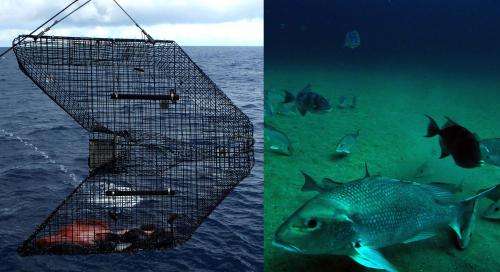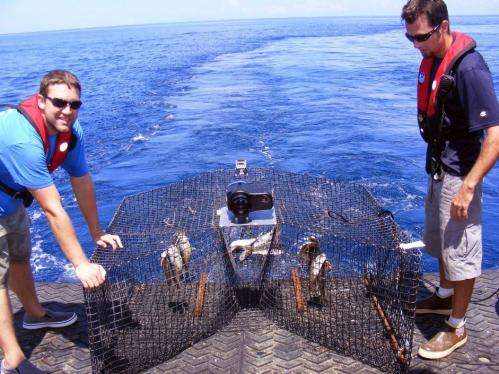When estimating fish populations, seeing is believing

Somewhere off the Atlantic coast of Florida, a fishing boat bobs in the swell, and Nate Bacheler helps swing a fish trap over the side. It's a big metal cage shaped like a giant arrowhead, and it looks like the standard design. But this is no ordinary fish trap, and Nate Bacheler is no ordinary fisherman.
Bacheler is a biologist with NOAA Fisheries, and each trap has two high-definition video cameras attached. Bacheler and other scientists are using fish traps like these to estimate the population size of reef fish, including some of the most important species in the Southeast, red snapper and gag grouper among them.
Traps without cameras work great for many species. But some species, like gag grouper, have a habit of avoiding fish traps.
"By attaching video cameras to fish traps, we can actually see and count gag grouper species and a variety of other species," that are wary of traps, Bacheler said.
The video and the trap each have their advantages. The video allows scientists to collect more precise abundance data on species that tend to avoid traps. And for all species, the traps allow scientists to get their hands on some fish, to weigh and measure them and to collect tissue samples.
"The two used in combination work better than either gear separately."
The Southeast Reef Fish Survey is conducted by NOAA Fisheries in partnership with the South Carolina Department of Natural Resources.
Fishermen and Scientists Work Together to Improve Data Collection
Reef fish occur mostly on hard bottom habitat, but most of the continental shelf off the Southeast United States is sand and mud. Very little of the shelf is mapped, so fishermen are helping scientists find the areas they need to sample by giving them the coordinates of their fishing spots.
"We're helping in every way we can to get the most accurate data," said Jimmy Hull, a commercial fisherman from Ponce Inlet, FL. In addition to being a fisherman, Hull owns Hull's Seafood Market and Restaurant, which employs 65 people full-time. "I'm in this so we can have sustainable fisheries forever, for my children and for all the people in this country. And the only way we're going to get that is through good, solid science and data collection and decisions based on science."

Scientists expect to use the combined trap and video data in upcoming stock assessments for red snapper and gray triggerfish. The data may or may not show that these fish are more abundant than previously thought. "But what the data will show is that the uncertainty will be decreasing around those estimates," said Bacheler. "And that benefits everyone. It benefits the scientists, and it benefits the fishermen."
"We're helping all we can," said Hull. "Do we agree on everything? No. Will we ever agree on everything? No. But we're going to get things done, because there's so much we do agree on."
Provided by NOAA National Marine Fisheries Service


















